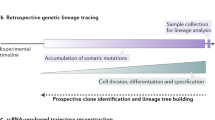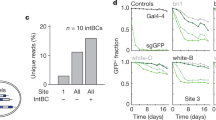Abstract
This protocol and the accompanying software program called LEVER (lineage editing and validation) enable quantitative automated analysis of phase-contrast time-lapse images of cultured neural stem cells. Images are captured at 5-min intervals over a period of 5–15 d as the cells proliferate and differentiate. LEVER automatically segments, tracks and generates lineage trees of the stem cells from the image sequence. In addition to generating lineage trees capturing the population dynamics of clonal development, LEVER extracts quantitative phenotypic measurements of cell location, shape, movement and size. When available, the system can include biomolecular markers imaged using fluorescence. It then displays the results to the user for highly efficient inspection and editing to correct any errors in the segmentation, tracking or lineaging. To enable high-throughput inspection, LEVER incorporates features for rapid identification of errors and for learning from user-supplied corrections to automatically identify and correct related errors.
This is a preview of subscription content, access via your institution
Access options
Subscribe to this journal
Receive 12 print issues and online access
$259.00 per year
only $21.58 per issue
Buy this article
- Purchase on Springer Link
- Instant access to full article PDF
Prices may be subject to local taxes which are calculated during checkout




Similar content being viewed by others
References
Giebel, B. & Punzel, M. Lineage development of hematopoietic stem and progenitor cells. Biol. Chem. 389, 813–824 (2008).
Ogawa, M. Differentiation and proliferation of hematopoietic stem cells. Blood 81, 2844–2853 (1993).
Cohen, A.R., Gomes, F., Roysam, B. & Cayouette, M. Computational prediction of neural progenitor cell fates. Nat. Methods 7, 213–218 (2010).
Cohen, A.R., Bjornsson, C., Temple, S., Banker, G. & Roysam, B. Automatic summarization of changes in biological image sequences using algorithmic information theory. IEEE Trans. Pattern Anal. Mach. Intell. 31, 1386–1403 (2009).
Al-Kofahi, O. et al. Automated cell lineage tracing: a high-throughput method to analyze cell proliferative behavior developed using mouse neural stem cells. Cell Cycle 5, 327–335 (2006).
Gonzales, R., Woods, R. & Eddins, S. Digital Image Processing Using MATLAB (Gatesmark Publishing, 2009).
Papadimitriou, C.H. & Steiglitz, K. Combinatorial Optimization: Algorithms and Complexity (Dover Publications, 1998).
Koller, D. & Friedman, N. Probabilistic Graphical Models: Principles and Techniques (MIT Press, 2009).
Ravin, R. et al. Potency and fate specification in CNS stem cell populations in vitro. Cell Stem Cell 3, 670–680 (2008).
Murray, J.I., Bao, Z., Boyle, T.J. & Waterston, R.H. The lineaging of fluorescently-labeled Caenorhabditis elegans embryos with StarryNite and AceTree. Nat. Protoc. 1, 1468–1476 (2006).
Shen, Q. et al. The timing of cortical neurogenesis is encoded within lineages of individual progenitor cells. Nat. Neurosci. 9, 743–751 (2006).
Gomes, F.L.A.F. et al. Reconstruction of rat retinal progenitor cell lineages in vitro reveals a surprising degree of stochasticity in cell fate decisions. Development 138, 227–235 (2011).
Eilken, H.M., Nishikawa, S.-I. & Schroeder, T. Continuous single-cell imaging of blood generation from haemogenic endothelium. Nature 457, 896–900 (2009).
Li, K. et al. Cell population tracking and lineage construction with spatiotemporal context. Med. Image Anal. 12, 546–566 (2008).
Chen, Y., Ladi, E., Herzmark, P., Robey, E. & Roysam, B. Automated 5-D analysis of cell migration and interaction in the thymic cortex from time-lapse sequences of 3-D multi-channel multi-photon images. J. Immunol. Methods 340, 65–80 (2009).
Qian, X. et al. Timing of CNS cell generation: a programmed sequence of neuron and glial cell production from isolated murine cortical stem cells. Neuron 28, 69–80 (2000).
Shen, Q. et al. Endothelial cells stimulate self-renewal and expand neurogenesis of neural stem cells. Science 304, 1338–1340 (2004).
Acknowledgements
This project was supported by the University of Wisconsin-Milwaukee, and by grant number NS033529 from the US National Institutes of Health (NIH) and by New York State Department of Health (NYSDOH) Contract C024352 from the Empire State Stem Cell Fund and the Regenerative Research Foundation. This project was also supported by NIH grant number R01EB005157 and by grant no. R01NS076709 from the National Institute of Neurological Disorders and Stroke. The authors would like to thank S. Shahmohammadi, R. Ference, A. DiRisio, S. Hardwick, S.M. Goderie, E. McAuley, R. Futia and C. Davenport for their help with cell culture and lineage validation.
Author information
Authors and Affiliations
Contributions
M.W., E.W., B.R. and A.R.C. designed and implemented the computational tools and algorithms, prepared the figures and wrote the manuscript. R.A.N.A. did cell preparation and maintenance, helped with staining and verified lineage trees. S.K.G., E.K. and S.T. cultured and imaged the NSCs, provided manual lineage reconstructions for comparison, edited the automated lineages, made suggestions on the design of the software tools from a biological perspective and helped prepare figures and write the manuscript.
Corresponding authors
Ethics declarations
Competing interests
The authors declare no competing financial interests.
Supplementary information
Supplementary Table 1
Comparison of the MAT tracking algorithm used by LEVER with the bipartite matching tracker originally developed in Al Kofahi, et al.5, and refined in Cohen, et al.4 Although automatic segmentation, tracking and lineaging algorithms continue to improve, even very low error rates translate to a significant number of editing operations in order to generate a fully corrected lineage tree. (DOC 34 kb)
Supplementary Video 1
This video shows the corrected lineage corresponding to Supplementary Data Set 1. This video was generated directly from LEVER (protocol, Step 26). (WMV 21380 kb)
Supplementary Video 2
This video shows a second corrected lineage. The image sequence data for this lineage was generated as described in Step 1 of this protocol, but was not provided due to space restrictions on the web server. This video was also generated directly from the LEVER program. This lineage was used to create Figure 2. (WMV 36802 kb)
Supplementary Video 3
This video shows an adult NSC lineage in the top frame and an embryonic NSC lineage below. The embryonic lineage is the same shown in Supplementary Video 2. Both lineages are zoomed to show cells on the lineage more closely. These movies were generated individually from the LEVER program. A separate MATLAB script then combined the two movies and added the white 25 µm scale bars. (WMV 29649 kb)
Supplementary Results
This Excel spreadsheet contains the results of exporting cell metrics from LEVER for Data Set 1. The data was sorted by field "origin cell". All cells whose origin cell was 243 (the lineage that we wish to analyze) were copied to the second worksheet labeled "clone 243". These cells were then sorted by the "first frame" field. The cell cycle time, average speed and average area were then converted to appropriate units and plotted to produce panel b of Figure 4. (XLSX 34 kb)
Rights and permissions
About this article
Cite this article
Winter, M., Wait, E., Roysam, B. et al. Vertebrate neural stem cell segmentation, tracking and lineaging with validation and editing. Nat Protoc 6, 1942–1952 (2011). https://doi.org/10.1038/nprot.2011.422
Published:
Issue Date:
DOI: https://doi.org/10.1038/nprot.2011.422
This article is cited by
-
Development of a 2D Automated Tracking System to Characterize Golgi-Derived Membrane Tubule Fission and Fusion Dynamics
Journal of Medical and Biological Engineering (2021)
-
Software tools for single-cell tracking and quantification of cellular and molecular properties
Nature Biotechnology (2016)
-
Lineage mapper: A versatile cell and particle tracker
Scientific Reports (2016)
-
Particle detection and tracking in fluorescence time-lapse imaging: a contrario approach
Machine Vision and Applications (2016)
-
CellProfiler Tracer: exploring and validating high-throughput, time-lapse microscopy image data
BMC Bioinformatics (2015)
Comments
By submitting a comment you agree to abide by our Terms and Community Guidelines. If you find something abusive or that does not comply with our terms or guidelines please flag it as inappropriate.



